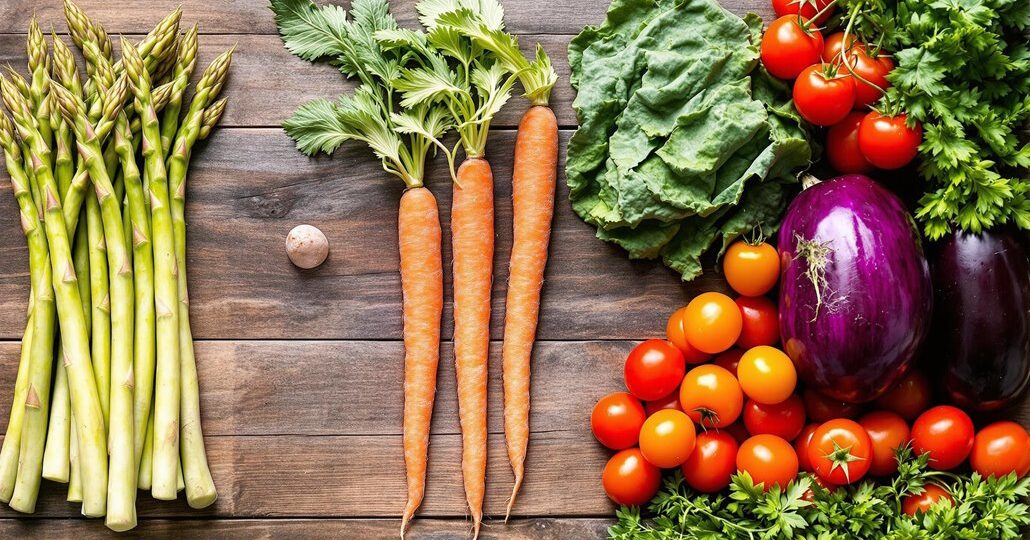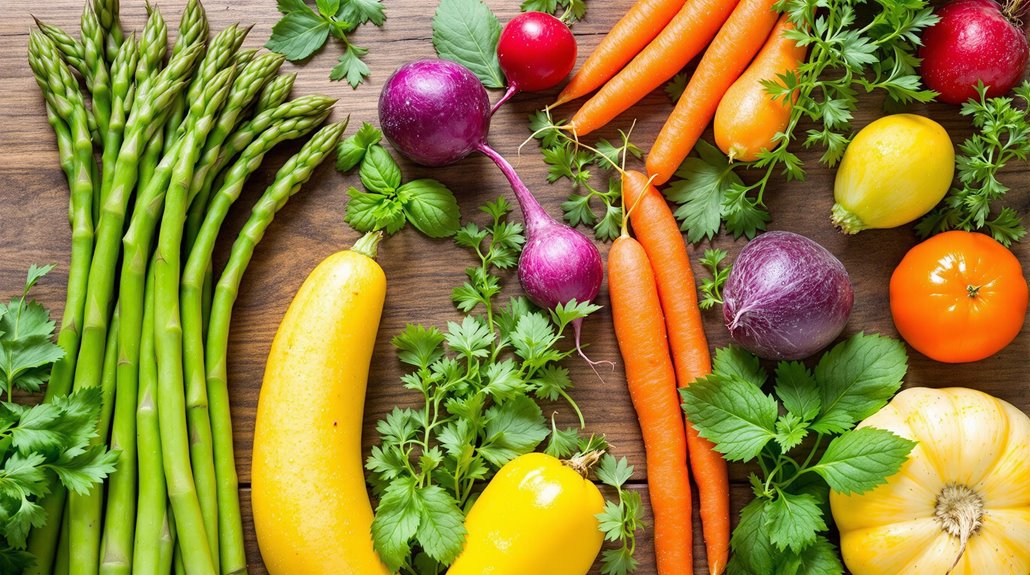Top March Vegetables for Healthy Meal Ideas
March 12, 2025 | by Nutrition Hub 101

March is a veggie party, and asparagus, spinach, and radishes are the VIPs! Grab those vibrant asparagus spears for an elegant side, throw in some spinach to boost your iron, and toss in crunchy radishes for that spicy zing. These green goodies won't just jazz up your plate; they'll keep you healthy and delighted. Trust me, your taste buds will thank you! Stick around to find out how to keep these veggies popping all month long!
Key Takeaways
- Asparagus is in season in March; it's nutrient-dense and low in calories, perfect for healthy meals.
- Spinach thrives in cooler weather, providing essential vitamins and antioxidants for a nutritious boost.
- Radishes are fresh and crisp in March, adding a peppery flavor and vibrant color to dishes.
- Incorporating these vegetables can enhance the nutritional profile of salads, stir-fries, and side dishes.
- Opt for fresh, seasonal produce for the best flavor and health benefits in March meals.
Asparagus

What it Looks like:
Asparagus is a vibrant green vegetable that often grabs attention with its slender, spear-like stalks. The tips of asparagus can range from a delicate green to a purplish hue, depending on the variety. When fresh, the stalks are firm and crisp to the touch, and they should snap easily when bent. Asparagus is typically sold in bunches, and you may also find white or purple varieties, which have their own unique flavors and textures. Whether grilled, roasted, or steamed, asparagus is a beautiful addition to any plate, often served alongside meats or incorporated into salads.
Why It's Smart:
Incorporating asparagus into your meals is a wise choice for a variety of reasons. First and foremost, it is a nutrient-dense vegetable, rich in vitamins A, C, E, and K, as well as fiber and folate. This makes it an excellent choice for maintaining overall health and supporting bodily functions, such as cell repair and immune system support. Additionally, asparagus is low in calories, making it an ideal ingredient for those looking to manage their weight. Its unique flavor profile adds a deliciously distinct taste to dishes, while its versatility allows it to be paired with numerous ingredients, enhancing both the nutritional value and culinary experience of your meals.
Things to Be Aware of:
While asparagus is generally safe for most individuals, there are several factors to keep in mind. For one, this vegetable contains a natural compound called asparagine, which can lead to a strong odor in urine after consumption. This phenomenon is harmless and varies from person to person based on genetic factors. Additionally, those with certain allergies or sensitivities may want to approach asparagus with caution. Fresh asparagus is best consumed shortly after purchase, as it tends to lose flavor and nutrients over time. Finally, if you're preparing asparagus for a large group, remember that the cooking time may vary depending on the thickness of the stalks, so adjust accordingly to guarantee even cooking.
Spinach

What it Looks like:
Spinach is a leafy green vegetable characterized by its tender, dark green leaves and slightly crinkled texture. It can be found in various forms, including fresh, frozen, or canned. Fresh spinach leaves are typically broad and can vary in size, ranging from small baby spinach leaves to larger varieties. When selecting fresh spinach, look for vibrant, crisp leaves that are free from wilting or yellowing. Its mild flavor and versatility make it a popular choice in salads, smoothies, soups, and cooked dishes alike.
Why It's Smart:
Incorporating spinach into your meals is a smart choice for several reasons. To begin with, it is low in calories yet high in nutrients, making it an ideal food for those looking to maintain a healthy weight while ensuring they get essential vitamins and minerals. Spinach is rich in iron, calcium, and vitamins A, C, and K, contributing to improved immune function, bone health, and overall well-being. Moreover, its high antioxidant content helps combat oxidative stress in the body, which can lead to chronic diseases. Using spinach in your meals can enhance the nutritional profile without compromising taste.
Things to Be Aware of:
While spinach is generally safe and beneficial for most people, there are a few factors to keep in mind. Spinach contains oxalates, which can interfere with calcium absorption and may contribute to kidney stone formation in susceptible individuals. If you have a history of kidney stones or are prone to calcium deficiencies, it may be wise to consume spinach in moderation or consult a healthcare professional. Additionally, when preparing spinach, it is essential to wash it thoroughly to remove any dirt or pesticides, especially if you are using fresh leaves. Cooking spinach can also help reduce oxalate levels, making the nutrients more bioavailable.
Radishes

What it Looks like: Radishes are vibrant root vegetables that come in a variety of shapes, sizes, and colors. The most common radish is the round, red variety, which has a crisp white interior. Other types, like the white daikon radish or the black radish, present unique appearances with their elongated shapes and darker skins. Regardless of the type, radishes typically have a crunchy texture and a peppery flavor that adds an invigorating bite to salads and other dishes. Their green tops are also edible and can be sautéed or used in pestos, making the entire plant versatile and appealing.
Why It's Smart: Incorporating radishes into your meals is a smart choice for anyone looking to enhance their diet with nutritious, low-calorie foods. Radishes are rich in vitamins C and B6, potassium, and antioxidants, all of which contribute to overall health. They are also high in fiber, which aids digestion and helps maintain a healthy weight. Their low caloric content makes them an excellent option for snacking or as a crunchy addition to salads, allowing you to enjoy a satisfying meal without excess calories. Additionally, radishes contain compounds that may help reduce the risk of certain cancers and improve liver function.
Things to Be Aware of: While radishes are generally safe and healthy to eat, some individuals may experience digestive discomfort if they consume them in large amounts, especially those who are sensitive to cruciferous vegetables. It's important to wash radishes thoroughly before consumption to remove any dirt or pesticide residues. Additionally, if you are growing radishes in your garden or purchasing them from a local farmer's market, be mindful of the season, as they are best enjoyed fresh in the springtime when their flavor is most pronounced. Finally, some people may find the strong peppery taste of radishes overwhelming, so it's advisable to start with small amounts and gradually incorporate them into your meals.
RELATED POSTS
View all


